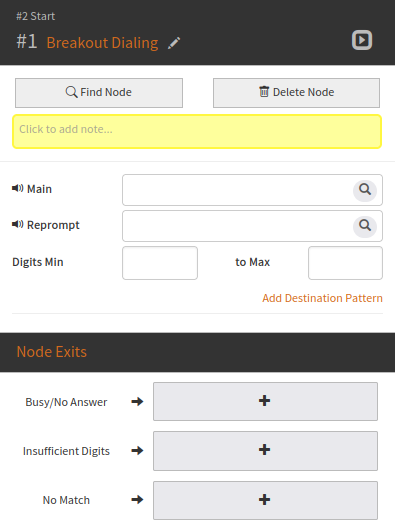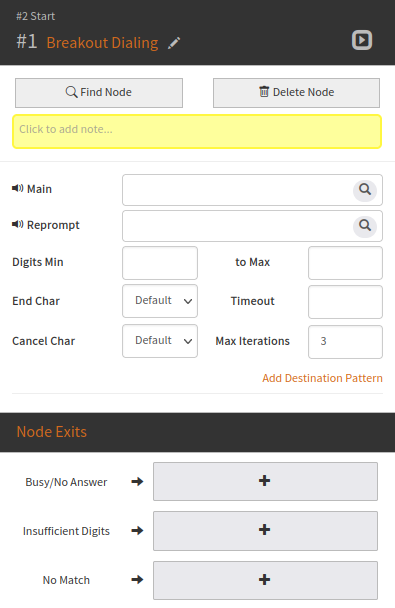Breakout Dialing
The Breakout Dialing Node
Category - Call Connection

The Breakout Dialing node prompts users to enter a number to be connected to.
The collected digits are stored in the internal buffer for the number to be connected to if checks succeed.
Should the user enter a number that is allowed, the call will
be connected. If the call completes successfully, the flow
ends. Otherwise, the Busy/No Answer exit is taken.
When the user does not enter an allowed number, the node will
re-prompt the user to enter a number until Max. Iterations
is reached (see below).
If Max Iterations is exceeded, the flow will exit down the
appropriate branch for the most recent failure condition, i.e.
Insufficient Digits or No Match.
Announcements must be selected for the Main announcement,
as well as the Reprompt announcement.
The minimum and maximum number of digits that are allowed to be entered must also be specified.

If additional configuration options are required, select the arrow icon in the header to display them:

Max. Iterations refers to the total number of attempts the
user is permitted before the failure branches are followed.
Both the End Char and the Cancel Char may be disabled if
required.
Additionally, the timeout value may be specified in order to override the SRF default timer.
Destination Patterns
Destination patterns may be added to the breakout dialing node. Destination patterns are used to verify that a number entered by the user is allowed to be used for the breakout dialing function.
For example, this may verify that the entered number is a local regional landline number.
Destination patterns are a form of regular expressions. Pattern matching rules are:
| Character | Description | |
|---|---|---|
| [123] | Match one of any character defined in a set, or within any defined range in the set. For example: [0-9] will match all digits 0-9 |
|
| ^021 | The ^ indicates the start of the digits. This pattern will match any number beginning with 021. |
|
| 63581140$ | The $ indicates the end of the digits. This pattern will match any dialled digits ending with 63581140. | |
| 9? | The ? represents matching "zero or one" of the preceding character. |
|
| 123* | The * matches zero or more of the preceding character. This example matches 12 and then any number of 3's (including 0). |
|
| 123+ | The + matches one or more of the preceding character. This example matches 123 and then any number of additional 3's (including 0). |
|
| . | Match any value. This example would match any digit. |
Examples:
| Example Pattern | Description | Example Matches |
|---|---|---|
| 021 | Match 021 somewhere in the digits dialled. The digits can appear anywhere in the entered digits string. |
021 |
| ^021 | Match when the digits dialled start with 021. The number of digits after 021 is not relevant. |
0210635462 |
| ^02[1-4] | Match when the digits dialled start with (or are exactly) 021, 022, 023, or 024. |
0210635462 |
| ^02[1-4].+$ | Match when the digits dialled start with 021, 022, 023, or 024, and is at least four digits long. |
0211, 0210635462 |
Configuration
To configure the node:
- Select the
Mainannouncement that is played to the user when the node is first encountered. - Select the
Repromptannouncement that is played to the user after an incorrect code is entered. - Enter the minimum number of digits that the entered number must be.
- Enter the maximum number of digits that the entered number may be.
- If required, add or remove
Destination Patternentries. - If required, set a new value for
Max Iterations. - If required, set a new value for
Timeout. - If required, set a new value for
End Char. - If required, set a new value for
Cancel Char.
Note that both announcements and minimum and maximum digits must be selected.